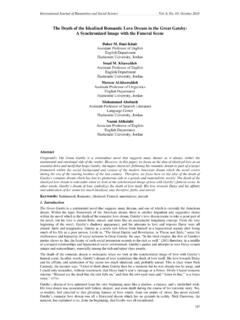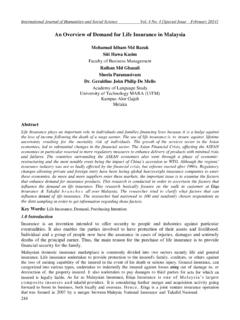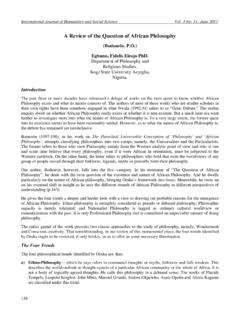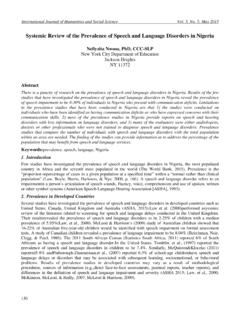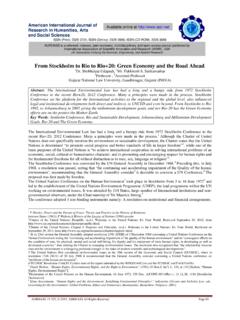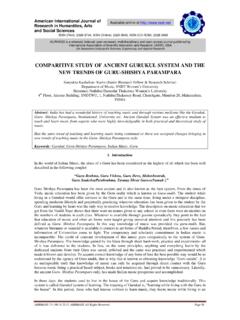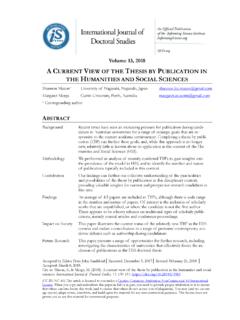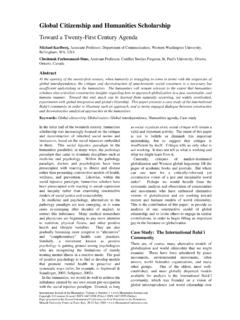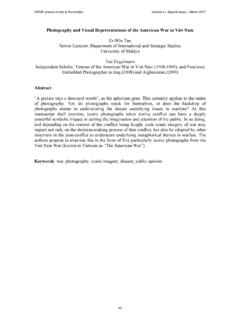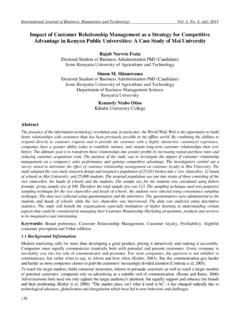Transcription of Child Marriage: A Cultural Health Phenomenon - ijhssnet.com
1 international journal of humanities and Social Science Vol. 3 No. 17; September 2013 97 Child marriage : A Cultural Health Phenomenon Jeniffer Birech Department of Sociology and Social work University of Nairobi Box 30197- 00100, Nairobi. Abstract Child marriage continues to be a challenge worldwide and especially in southern Asia and Africa. While it affects both sexes, girls are more affected as they are the majority of the victims. Child marriage causes untold suffering to the victims; it curtails the Child s education, affects the general Health , and puts the affected in a disadvantaged position. From this paper, culture continues to perpetuate and entrench the practice of Child marriage in most communities. This paper discusses the Cultural factors behind the practice of Child marriage such as bride wealth, value of virginity among others. It also examines the Health implications on the life of the children as well as the strategies put in place by various stakeholders in order to end the practice.
2 The paper recommends that the communities should be actively involved in coming up with the ways of ending the practice. Awareness should be created on the negative implications of Child marriage on the Health of the children and their general wellbeing. Key words: Child marriage , Culture, Health , Kenya 1. Introduction Child marriage refers to any marriage of a Child younger than eighteen years old, in accordance to article 1 of the Convention of the Right of the Child . According to CEDAW, the right to protection from Child marriage in article 16 states; The bethrothal and the marriage of a Child shall have no legal effect, and all necessary action including legislation , shall be taken to specify a minimum age for marriage (UN Committee on the Elimination of Discrimination Against Women (CEDAW), 1994). While marriage is not considered directly in the convention on the rights of the Child , Child marriage is linked to other rights such as the right to express their views directly, the right to protection from all forms of abuse and the right to be protected from harmful traditional practices and this is frequently addressed by the committee on the rights on the Child .
3 Child marriage was also identified by the Pan African Forum against Sexual Exploitation of children (Mikhail, 2002). According to World Health Organization, Health refers to a complete state of wellbeing, mental, physical and social and not merely the absence of diseases (WHO, 1946). This implies that certain social/ Cultural aspects affect the Health of an individual. On the other hand, culture refers to a way of life of members of a society or groups within a society. It includes how they dress, their marriage customs and family life, their patterns of work, religious ceremonies and leisure pursuits (Giddens, 2001). Culture and community are closely related, in fact, they are enmeshed hence, affecting the Health of an individual or the community. This explains the persistence of the Child marriage as a way of life in some communities. In India, almost half ( ) of women aged 20-24 years got married before they reach eighteen years (Sinha, 2009).
4 Further, girls in India grow up with the normative expectation of marriage within a socially determined social frame. Indeed, this shows that culture is rooted in the societal structures. In Latin America and the Carribean, 29% of young women were married by age of 18. In Southern Asia 48% (nearly 10 million) of young women were married before the age of 18. In Africa, 42% were married before turning 18 (UNICEF, 2005). In Ethiopia and some West African Countries, some girls get married as early as 7 years. In Bangladesh, 45% of young women between 25 and 29 were married between the age of 10 and 14 (UNICEF, 2001). Studies have shown that approximately half of Yemeni girls are married before 18, while some as young as eight (Carla, 2009). Initially, Yemeni law set the minimum age for marriage at 15 but tribal customs often flouted it. In 1999, the minimum marriage age of 15 for women was abolished; the onset of puberty, interpreted by conservatives to be at the age of nine, was set as a requirement for consummation of marriage (Human Rights Watch, 2001).
5 In practice, "Yemeni law allows girls of any age to wed, but it forbids sex with them until the indefinite time they are suitable for sexual intercourse (Carla, 2009). Center for Promoting Ideas, USA 98 According to international Center for Research on Women (ICRW), in Niger, Chad and Mali, more than 70% of girls are married off before the age of 18, whereas in Bangladesh, Uganda, India, Zambia, and Tanzania, the range is between 40 and 50 % (UNFPA, 2005). These findings are presented in table 1. In Kenya, Child marriage is not a new Phenomenon . It is quite common especially among the pastoralist communities such as the Samburu, Maasai, and the Pokot. For example, a 10 year old in Samburu was married off to a 55 year old man (Daily Nation, June, 2008). To them, it is Cultural and is seen as a way of life. In some areas in Nyanza, Child marriage is quite prevalent (Bruce et al.)
6 , 2006; Glynn et al., 2001). 2. Reasons Behind Child marriage Cement Alliances The reasons behind Child marriage vary from one country to another. Most studies have shown that the dominant reason is culture. Yet in most cases, it is easy to demonise the practice without even attempting to find out the socio- Cultural factors. According to the study done in Ethiopia by ICRW, children are betrothed before birth to cement the strategic alliances between families ( international Center for Research on Women, 2007). This aspect of bethrothal was also common among the Maasai of Kenya, although it has reduced with social change in the society. In South Africa, the law provides for respecting the marriage practices of traditional marriages, whereby a person might be married as young as 12 for females and 14 for males enhancing the practice (Nawal, 2006). Bride Wealth Closely related to the above is the aspect of bride wealth.
7 It is a Cultural Phenomenon not only in Africa but also outside. In India, bride wealth as a gift to a daughter married is like a bribe to the groom for taking one s daughter off one s hands (Rao, 1993). This is closely tied to the fact that culturally women are of low status as compared to men. Additionally, grooms of different professions have unspoken but well established rates for bride wealth. In some, the bride price decreases as the girl gets older. This implies that parents would want to marry off the daughters as fast as possible. Bride wealth enhances the practice in most African communities as it is highly valued and encourages parents to marry off their children soon (UNICEF, 2001). It is a source of wealth and prestige when given in the form of livestock such as cattle, goats, and sheep among others. The more livestock one has the more wealthy one is, hence, more respect. Women status in the community The status of women in society plays a key role in Child marriage , women are seen as inferior, and hence, they are neglected and despised (World Youth Report, 2003).
8 As a matter of fact, in India, the birth of a girl is often an occasion of heartbroken sorrow and despair, even in relatively affluent and educated families. A girl is seen as a burden given the fact that they will get married and leave the natal family. The parents prefer to educate boys and marry the girls off at an early age. A male Child is more likely to gain full education, gain employment and pursue a working life, thus tending to marry later. In Mali, the female: male ratio of marriage before age 18 is 72:1; in Kenya, it is 21:1 (Nawal, 2006). Virginity The importance of virginity is valued in many communities. In India, virginity is highly valued and the girls are expected to observe (Fernandes, 2013). The younger the bride, the likelier she is to be a virgin. In most African communities, virginity was highly valued and the girls who broke their virginity were a laughing stock.
9 It is considered that shame would be cast on a family if a girl was not a virgin when she marries. Therefore, in order to ensure that a girl's virtue remains intact, girls may be married earlier, in order to ensure their virginity. Poverty More often than not, Child marriage takes place due to poverty. It can be argued that poverty is related to culture to a certain degree. This is due to the fact that some people do not work hard and have cultivated the spirit of dependence. Where there is acute poverty, a young girl may be seen as an economic burden, when purchased will relieve the family financially and socially ( international Center for Research on Women, 2007). Hence, marriage is considered a transaction, a significant economic activity. In most African communities, bride wealth is linked with marriage . In the context of Poverty, therefore, this practice encourages Child marriage . In addition, some communities do not regard the education of the girl highly as that of the boy.
10 The girls are married off early and are seen as a source of wealth. international journal of humanities and Social Science Vol. 3 No. 17; September 2013 99 3. Implications of Child marriage Child marriage causes untold suffering to the victims. It results in lost of development opportunities, limited life options and generally poor Health . Child marriage curtails the girls education and affects their Health among others (Bruce, 2007). Various studies show a strong correlation between a woman s age at marriage and level of education. Large number of girls who drop out of school do so because of early marriage leaving many women illiterate (UNICEF, 2001). Due to lack of education, the married women are not empowered socially and economically, they lack decision making power, girls social networks and even the ability to negotiate with partners and family over healthy behaviours (Bruce, 2007).

